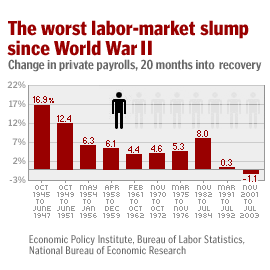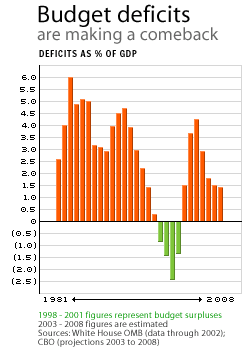NEW YORK (CNN/Money) - U.S. workers returned to the job Tuesday in an economy clearly stronger than it was in the spring and summer, and economists have high hopes the rebound will accelerate through the winter into 2004 and beyond.
But many economists believe that, after the impact of recent tax cuts and child-tax credit checks pass through the economy, there are several speed bumps on the road to a long-lasting rebound. Though it seems doubtful these jolts would trigger another recession, they could mean that 2004 ends up looking a lot like 2002 and 2003, with stretches of sluggish growth.
Labor-market pain
Though unemployment, which clocked in at 6.2 percent in July, never got as bad as it did in prior recessions, it's also the worst in nine years, and it seems unlikely to fall significantly for several months -- economists surveyed by the Philadelphia Federal Reserve believe it will average 5.9 percent in 2004.

In addition to making people nervous, a lousy labor market keeps a lid on wage growth, and some economists worry it will persuade consumers to keep a lid on their spending, which makes up more than two-thirds of the economy.
"While employment is a lagging indicator, the economy does need to start generating new employment over the next few months or consumer confidence and spending could suffer," Richard Nash, chief market strategist at Victory Capital Management, said recently.
Higher interest rates
Since bottoming out at 3.07 percent in mid-June, the yield on the 10-year Treasury note has exploded to 4.54 percent, one of the most dramatic swings in bond-market history, triggering a similar jump in 30-year mortgage rates.
| Related stories
|

|
|
|
|
Though bond yields could fall again -- especially since the Federal Reserve has promised to keep short-term rates low for a long time -- their recent jump might already have done damage to economic growth in 2004 by killing the refinancing boom and setting the housing market up for a slowdown.
"The increase in long-term interest rates is likely to subtract about one percentage point from real GDP growth," Goldman Sachs economist Jan Hatzius said in a research note earlier this month. "Although this will not prevent the economy from accelerating in the second half of 2003, it is likely to push growth back down to a below-trend pace in 2004."
Rising deficits, debt
Interest rates also could be pushed higher by a surging federal budget deficit. If the government issues more debt when there's high demand for other kinds of debt, such as corporate bonds, then yields must rise to compete for investors' attention.

Also worrisome to some economists is the ever-enormous budget and current account deficits, which measures the flow of goods, services and money between the United States and other economies. By running this deficit, America is basically borrowing money from the rest of the world, in the form of about $2 billion of foreign investment every day.
Worries about these "twin deficits" have never really amounted to much, but the fear is that sluggishness in the U.S. economy could sap overseas investors' appetites for U.S. assets, causing stock prices to fall and interest rates to rise. Though the dollar's value also would sink, helping exporters sell goods overseas, the other effects of a current account correction would hurt the economy.
Many economists also worry about the debt burden of households and businesses. Though low interest rates and rising wages have eased the sting of debt payments, the ratio of corporate and household debt to GDP is still near a record high, as is the percentage of household disposable income spent on debt service, and private-sector debt was 180 percent of GDP in the first quarter of 2003.
"The U.S. cannot increase private sector debt indefinitely. It cannot increase government debt indefinitely. And it cannot increase external debt indefinitely," UBS Warburg chief global economist George Magnus wrote recently. "A U.S.-led global expansion is ... doomed to end at some stage, even if the dollar resumes its downward trend during the course of next year."
Security
"Geopolitical uncertainty" in advance of the U.S.-led war with Iraq earlier this year helped fuel a dramatic economic slowdown. Though some of the worst worries about the war never came to pass, the world is still an uncertain place, with post-war Iraq and Afghanistan still unsettled, the Israeli-Palestinian struggle far from resolution and North Korea and Iran apparently rushing to make nuclear weapons.
The costs associated with these troubles, along with increased money spent on security -- both physical and digital -- may show up only on the margins, adding a bit to corporate costs and draining money from the private sector to the government.
But another major terror attack, on or near the scale of the Sept. 11 attacks, would likely devastate the U.S. and global economies, and another war could have a similar effect.
Energy
Fed Chairman Alan Greenspan warned earlier this year about the potential economic harm done by higher natural gas prices. The supply shortages that pushed prices higher in the summer could become much more damaging as the United States moves into winter, when natural gas demand rises.
Oil prices also have remained stubbornly high, due in part to an inability to get Iraq's oil production back up to speed, along with other supply issues in places such as Venezuela and Nigeria.
Higher energy prices act as a sort of tax on households and businesses, taking money away from potential discretionary spending and business expansion.
"We have very high energy costs, rising mortgage rates, reduced tax stimulus and no sign of what we really need to be convinced that the economy is on the precipice of a self-sustaining multi-quarter trend of above-potential growth, otherwise known as employment growth," said David Rosenberg, chief North American economist at Merrill Lynch.

|

